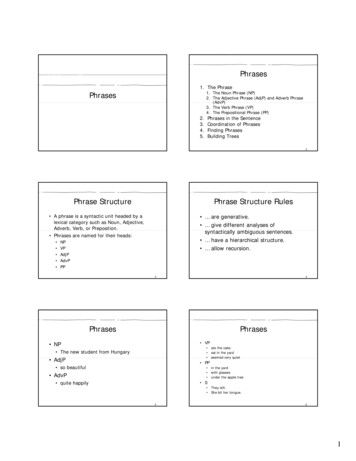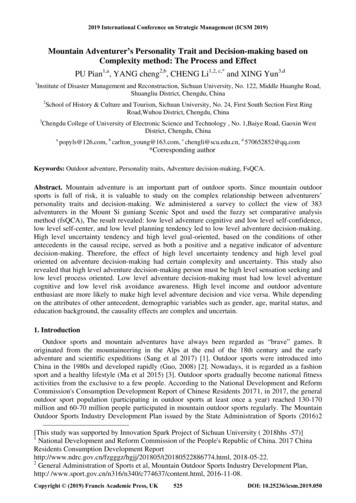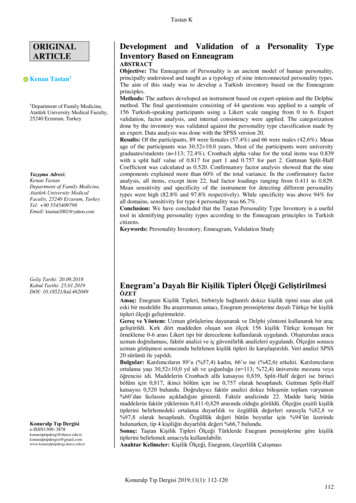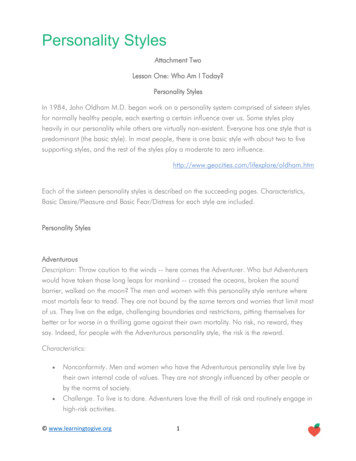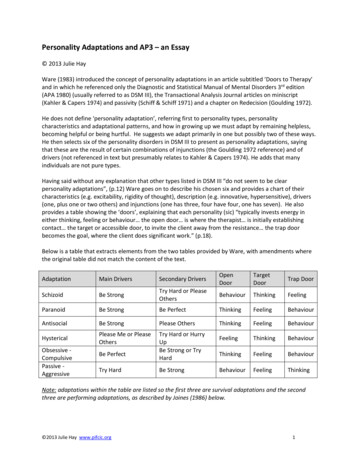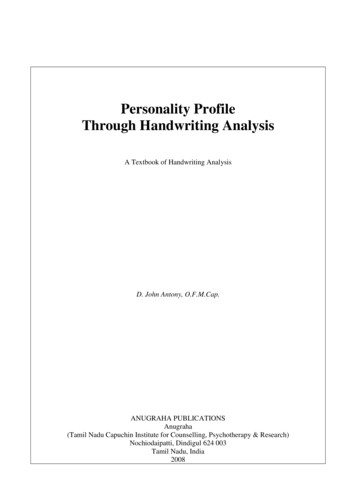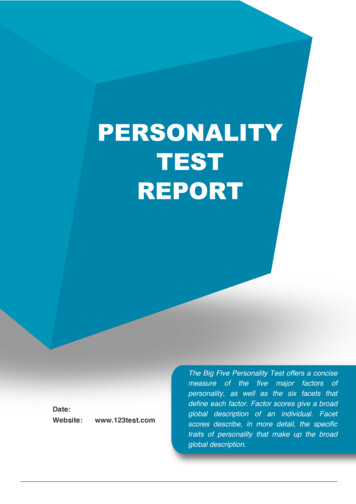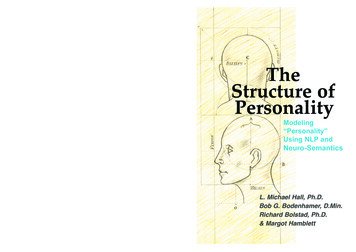
Transcription
The Structure of Personality begins by exploring how we actively ‘pattern’ experience.Guiding us through the cognitive system of internal representation, it examines thecontexts and environments in which such patterning arises, and the higher levels atwhich we produce beliefs and values that determine our behaviors. Once it hasidentified the process of ‘producing a personality,’ it presents strategies that will alterthose behaviors and reprogram personality, targeting each stage of personalityproduction —and in particular, the stage at which the client forms core beliefs.Coaching the reader in a number of effective and specially adapted NLP techniques,The Structure of Personality includes reordering strategies such as the R.E.S.O.L.V.E.model—that ingeniously sequences a number of key tasks that form an important part ofchange work, and the Personal Strengths Model—that determines which NLPtechniques will be useful for you or for your client. Addressing general and specificbehavior problems, such as schizophrenia, paranoia and addiction, it is an essentialreference for counselors, therapists and NLP practitioners, presenting effective solutionsto personality disorders.“A bold and courageous step with exciting possibilities. The authors have dismantled thediagnostic nomenclature offering new perspectives for treatment while postulating thatpersonality is not static; not a thing, but an ongoing, evolving process and, if dysfunctional, canbe restructured. The book should prove to be a milestone in our pursuit for sanity.”Rie Anderson, M.A., LMHC, NBCDCH, Clinical Psychotherapist.“The Structure of Personality is a major step in creating a cognitive map using Neuro-Semanticsand Neuro-Linguistic Programming to understand the relationship between a person’s thinkingand his or her personality development.”Jim Walsh, M.A., Licensed Mental Health Counselor, Certified School Psychologist,Certified Neuro Semantics and Neuro Linguistics Trainer.L. Michael Hall, Ph.D. is a researcher, modeler and prolific author who works as apsychotherapist and trainer in Grand Junction, Colorado. He originated and developed theMeta-States Model in1994, and co-founded Neuro-Semantics with Bobby Bodenhamer, D.Min.The Structure of PersonalityPersonality is not a ‘thing,’ it is a process. When we discuss personality,what we are talking about is a system of responding and relating or, moreprecisely, a set of behaviors. This is good news for those who deal with, orsuffer with, personality problems. What it means is that personality can bereordered and reprogrammed in a way that is both beneficial andliberating.TheStructure ofPersonalityModeling“Personality”Using NLP andNeuro-SemanticsBobby G. Bodenhamer, D.Min. has been director and trainer for the NLP Center in GastoniaNC for more than a decade, and is now director of the First Institute of Neuro-Semantics.Richard Bolstad, Ph.D. is an NLP trainer and developer of the Transforming CommunicationSeminar who lives in New Zealand.Margot Hamblett was also an NLP trainer, co-developer of the Transforming CommunicationSeminar with Richard, and his life partner, until her recent death.HallBodenhamerBolstadNLP90000Crown House Publishing mtSoP FP 0311.indd 1HamblettISBN 978-184590675-7L. Michael Hall, Ph.D.Bob G. Bodenhamer, D.Min.Richard Bolstad, Ph.D.& Margot Hamblett9 7 81 845 9067 5 713/04/2011 10:33
Prelims.qxd06/02/0310:26Page iThe Structure ofPersonalityModeling “Personality” UsingNLP and Neuro-SemanticsL. Michael Hall, Ph.D.Bob G. Bodenhamer, D.Min.Dr. Richard Bolstad& Margot HamblettCrown House Publishingw w w. c ro w n h o u s e . c o . u k
Prelims.qxd06/02/0310:26Page iiFirst published in the UK byCrown House Publishing LimitedCrown BuildingsBancyfelinCarmarthenWalesSA33 5NDUKwww.crownhouse.co.uk L. Michael Hall, Ph.D., Bob G. Bodenhamer, D.Min.,Dr. Richard Bolstad & Margot Hamblett 2001Reprinted 2003.The right of L. Michael Hall, Ph.D., Bob G. Bodenhamer, D.Min.,Richard Bolstad and Margot Hamblett to be identified as the authors ofthis work has been asserted by them in accordance with the Copyright,Designs and Patents Act 1988.All rights reserved. Except as permitted under currentlegislation no part of this work may be photocopied, stored in a retrievalsystem, published, performed in public, adapted, broadcast, transmitted,recorded or reproduced in any form or by any means, without the priorpermission of the copyright owners. Enquiries should be addressed toCrown House Publishing Limited.British Library of Cataloguing-in-Publication DataA catalogue entry for this book is availablefrom the British Library.ISBN 1899836675LCCN 2002117317Neuro-Semantics is a registered trademark in the USA and othercountries by the Society of Neuro-Semantics.Printed and bound in the UK byBell & Bain Ltd, Glasgow
Prelims.qxd06/02/0310:26Page iTable of ContentsForeword . iiiPreface 1 . ixPreface 2 . xvPart I:NLP and NS Models for Understanding theStructure of “Personality” . 1Chapter 1“Personality” and the Meta-Model . 3De-Nominalizing “Personality” for Clarity(Hall & Bodenhamer)Chapter 2The Meta-States Model and “Personality” . 17“Personality” as a Gestalt of Higher States(Hall & Bodenhamer)Chapter 3The Strategies Model and “Personality” . 51“Personality” as a Strategy(Bolstad & Hamblett)Chapter 4Meta-States, Design Human Engineeringand “Personality”. 67“Personality” Embodied as an EnergizedHolographic Force Field(Hall & Bodenhamer)Chapter 5The RESOLVE Model and “Personality” . 91Using NLP for Resolving Problems(Bolstad & Hamblett)Chapter 6“Personality” as Meta-Level Phenomena. 111Central Meta-Level Phenomena Structuring“Personality” i.e., Beliefs, Values, etc.(Hall & Bodenhamer)Chapter 7The Personal Strengths Model and “Personality” . 127(Bolstad & Hamblett)Chapter 8Modeling the Structure of Pathology . 141The Central Mechanisms of Disordering(Hall & Bodenhamer)i
Prelims.qxd06/02/0310:26Page iiThe Structure of PersonalityChapter 9Modeling Pathology . 153The Central Mechanisms for Disordering “Personality”(Hall)Chapter 10When Things go Wrong. 169The Role of Trauma in Personality Disordering(Hall & Bodenhamer)Chapter 11Re-discovering the Healthy “Personality” . 183An Alternative Model to “Personality”via the DSM-IV (Bolstad & Hamblett)Chapter 12NLP and NS Patterns for Transforming“Personality” (Hall) . 201Part II:Specific “Personality” Disordering. 249Chapter 13Double-Binding and Schizophrenia . 251Chapter 14Disordering “Personality” Through Paranoia . 299Chapter 15Disordering “Personality” ThroughAnti-Social Frames . 309Chapter 16Disordering “Personality” Through Depressing . 321Chapter 17Borderline Disordering of “Personality” . 343Chapter 18Disordering “Personality” Through HistrionicDisordering . 373Chapter 19Disordering “Personality” Through Narcissism . 381Chapter 20Disordering “Personality” Through Avoidance . 389Chapter 21Disordering “Personality” Through Dependence . 399Chapter 22Obsessive-Compulsive Disordering . 405Chapter 23Disordering “Personality” ThroughBecoming Addictive . 415Chapter 24Disordering “Personality” Through Anxiety-ing . 435Chapter 25You and Your “Personality” . 453Chapter 26Personality and the Matrix . 455NLP and Neuro-Semantic Resources and Patterns . 457Bibliography . 459ii
Prelims.qxd06/02/0310:26Page ixPreface 1lCan we change “personality?”lWhat is this thing that we call “personality” anyway?lWhat does the NLP model say regarding “personality?”lWhat NLP models and techniques transform personality?lWhat Meta-Stating and Neuro-Semantic models expand andextend the art of transforming “personality?”As a Cognitive-Behavioral psychologist, when I first discoveredNLP (Neuro-Linguistic Programming), I felt immediately excited.And during the past fourteen years, my exploration of the modelhas not waned or disappointed me. I quickly recognized that itspowerful techniques and processes would revolutionize the waywe work with people. And so it has.Further, NLP arose from modeling the therapeutic “magic” of threetherapeutic experts involved in three very different disciplines,Virginia Satir of Family Systems, Fritz Perls of Gestalt Therapy, andMilton H. Erickson of Ericksonian hypnosis. It was out of modelingthose different fields that a Cognitive Behavioral Model arose. Thisspeaks about the precision of the modeling skills of the two cofounders, Dr John Grinder as a linguist and Richard Bandler as apatterning genius.At its essence, NLP describes a communication model—how we uselanguage and how we “make sense” of language. From there, NLPrefers to a model of human functioning—how we operate in theworld making mental-emotional maps that give us a “program”for navigating life. From there, NLP references an entire metadomain that examines the structure of experiences in general andprovides modeling tools for unpacking the strategies, refiningthose programming strategies, and then replicating exemplars ofexcellence. And yet, as you will discover in this work, NLP is evenmore than all of that.ix
Prelims.qxd06/02/0310:26Page xThe Structure of PersonalityHere we focus on NLP and Personality. As such, this work extendsthe current research and practice of the Cognitive-BehavioralModel. That’s because as a meta-domain, NLP cares very littleabout theory as it focuses primarily on processes for change and onthose patterns that work to bring about transformation. Giventhat, NLP studies processes that work in many different fieldswithout a compulsion to create some unified field theory. Thismakes NLP extremely practical and focused on solutions andresults.While it cares little about theory, that doesn’t prevent many of usin the NLP field from exploring the epistemological foundations ofthe model. The terms “Neuro-Linguistics” and “NeuroSemantics” actually originated with Alfred Korzybski (1933/1994)founder of General Semantics. The focus on Meta-Levels andframes originated from anthropologist Gregory Bateson (1972,1979) who set the foundations also for cybernetics, meta-cognition,and systems theory.Here we also present more than NLP, we present Neuro-Semantics.This represents an extension and expansion of the NLP modelusing the Meta-Levels model, the Levels of Thought. This refers tothe self-reflexivity that drives the Meta-States model. In the pastfew years, we have discovered that the most powerful NLP patterns operate due to the frame-setting power of state upon state sothat “mind” or “consciousness” becomes textured and layeredwith higher level awarenesses. This, in turn, leads to a richer andmore resourceful kind of mindfulness in moving through theworld.NLP/NS and “Personality”Early in the development of NLP, it became apparent to many thatthis model of human functioning which involved understandingand exploring the cognitive maps that people develop and use fornavigating “reality,” had tremendous implications for “personality.”Lewis (1982) describes how he titled his original from his studiesunder Richard Bandler and John Grinder as “A Model for a Processx
Prelims.qxd06/02/0310:26Page xiPreface 1Theory of Personality.” He understood, as many who followed, thatwhen we change someone’s reference structure (i.e., one’s “model ofthe world”) “personality” itself changes. It has to.In 1988, Wyatt Woodsmall and Tad James wrote the first book onone of the most exciting NLP domains, time-lines. In Time LineTherapy: The Basis of Personality they presented NLP patternsregarding how we code and process the concept of “time” andshowed how this mapping or programming plays a central role in“personality.” They also identified other key components of personality in addressing the NLP domain of the Meta-Programs.When Dr Bodenhamer and I co-authored our work on MetaPrograms (1997), we sought to extend the perceptual filters byintegrating facets of Cognitive Psychology, General Semantics,and Developmental Psychology. Figuring Out People: DesignEngineering Using Meta-Programs (1997) most essentially addressespersonality. The research and writing that went into that workrenewed in both of us an interest in applying NLP to personalitydisorders. As it did, we began thinking and planning a second volume of Figuring Out People with the focus on personality.In that discussion, we agreed about the value of following upFiguring Out People with a more scholarly work, and specificallyone that would apply the numerous domains and models withinNLP to the more serious problems of “personality disorders.” As aresult, while I began writing a text to that end, Bob used his counseling practice to think through and apply the concepts on a dailybasis with people suffering from many different kinds of “personality disorders.”During the next year, as we continued to think abou
Using NLP and Neuro-Semantics L. Michael Hall, Ph.D. Bob G. Bodenhamer, D.Min. Richard Bolstad, Ph.D. & Margot Hamblett Hall Bodenhamer Bolstad Hamblett The Structure of Personality ISBN 978-184590675-7 9 781 845 906757 9 0 0 0 0 Crown House Publishing Ltd www.crownhouse.co.uk www.crownhousepublishing.com NLP Personality is not a ‘thing,’ it is a process. When we discuss
